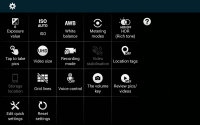Samsung Galaxy Note Edge review: The other side
The other side
Camera
The Samsung Galaxy Note Edge shares a camera with the Galaxy Note 4. It uses 16MP Sony sensor, which has a native 16:9 aspect ratio so it produces widescreen images that can be viewed in full in the gallery and on the majority of monitors.
The main camera has an aperture of f/2.2 and offers optical image stabilization, but lacks the phase-detection autofocus of the Galaxy S5 (and its Samsung-made sensor). The front-facing camera has a wider aperture (f/1.9) so it should be a little better in low light and shoots 3.7MP stills (that's exactly QHD resolution).
The camera makes use of the Edge screen to position its controls on what could be considered "on top". That's where the shutter key goes, the video record button and mode button, along with the front/back camera and HDR toggles. This leaves the main display dedicated to the viewfinder.
This setup mimics having hardware buttons on the side. It's far from perfect though - shooting one-handed is nearly impossible. If you have big hands you may be able to come up with a workable setup but most of the time taking photos is a two-handed affair.
Also, shooting in portrait isn't perfect because the keys go on the side. The shutter key does move closer to the center so it's easier to reach, but it's still awkward.




The camera uses the Edge screen for its primary controls
Camera options include Selective focus (faking a bokeh effect), Panorama and Rear-cam selfie. The last one lets you select a region where you want your face and the phablet will snap a photo when it's perfectly positioned. Another selfie trick uses the heart rate monitor as a sort of make-shift button - when your face is in view, putting your finger on the HR monitor acts as pressing the shutter key.
Additional modes are available but disabled by default - Shot & more, Dual Camera, Virtual Tour and Beauty face. Samsung has moved 6 of its other proprietary shooting modes to the Galaxy Apps store as downloads, a part of the effort to lighten TouchWiz.
The Samsung Galaxy Note Edge takes excellent pictures, its high resolution sensor is used to full effect. We appreciate the wider aspect of photos, but the camera's Field of View is not actually wider than a typical 4:3 shooter.
Photos are sharp and rich in detail, with noise kept at a very comfortable level. The sharpness is even across the frame with minor corner softness on the sides. The camera has a tendency to overexpose highlights but keeps decent detail in the shadows.
Colors are tuned up a little (within reason for a consumer device) and the white balance is spot on. If you're having troubles with exposure you can press and hold on an area of the frame to the activate autofocus and auto exposure lock.
In macros the Galaxy Note Edge does quite well - you can get close to the subject and the background gets a decent blur.




Samsung Galaxy Note Edge camera samples
HDR mode is quite reigned in - it brings in some more detail in both highlights and shadows, without sacrificing much of the contrast or adding extra noise. Note that HDR takes multiple exposures and that lowers the sharpness a little when they are combined.




HDR Off (left) • HDR On (right)
Panoramas come out at an incredibly high resolution. The maximum resolution in portrait shooting is a whopping 56.6MP (Apple just upgraded the maximum Panorama resolution for the latest iPhones to 43MP), while in landscape you get a decent 28MP. Detail is great, especially in the higher-resolution of the two and the stitching is among the most accurate.
![]()

Samsung Galaxy Note Edge panoramas: shot in landscape • in portrait
A panorama option is available for the front-facing camera as well. It's called Wide selfie and works by rotating the phablet around its axis (and not around your face).
The photo quality comparison tool allows you to compare the Samsung Galaxy Note Edge against its Galaxy Note 4 sibling and other phablets. Most of them shoot 4:3 though, so that's the mode we used for the charts.



Samsung Galaxy Note Edge in our photo compare tool
Superb 4K video
The Samsung Galaxy Note Edge captures 2160p videos at 30fps as a maximum but also offers 1080p videos at both 30fps and 60fps and also 1440p videos at 30fps in between.
The maximum resolution videos (2160p, aka 4K or UHD) carry the highest bitrate among the pack - almost 50Mbps. The framerate was a constant 30fps and smooth enough. Audio is captured at a very high 256Kbps with clean stereo sound.
The level of resolved detail of the 2160p UHD videos is impressive - it's like viewing a live, animated 8MP image (8.3MP to be exact). UHD videos carry the same good characteristics of the still shooting mode - great, vivid colors, everything in sharp focus and a tendency to overexpose the frame. Here goes a sample.
The regular 1080p videos at 30fps carry an okay bitrate of 17-18Mbps with the same great audio capture. There is plenty of detail in the regular FullHD video but, compared to the UHD video, the lower resolution is evident. The upside is that you can apply lossless zoom in FullHD videos - up to 2x zoom without loss of detail.
And if that's not enough you can shoot QHD (1440p) videos that fit snugly on the screen.
And finally 1080p videos at 60fps. Those are mainly meant to show smoother motion but don't have as much detail as 30fps 1080p videos. The difference isn't dramatic - there's still plenty of detail to go around. The doubled framerate allows for extremely smooth movement in the video. 1080p@60fps videos have around 28Mbps of bitrate.
You can also directly download the - 2160p@30fps (0:15s, 90.3MB), 1440p@30fps (0:14s, 42.9MB), 1080p@30fps (0:15s, 31.6MB) samples.
The Samsung Galaxy Note Edge uses its optical image stabilization for videos just as well. Vertical and horizontal panning seems smoothed over though it's not perfect. The good, old digital stabilization is still available but it only works at 1080p or below.
If you want to pixel peep deeper in the Samsung Galaxy Note Edge's footage you're welcome to give our video comparison tool a try.
Reader comments
- Anonymous
- 30 Mar 2022
- 3Hh
Don't say samsung is shit
- DPJ shina
- 17 Oct 2021
- fsV
Please make some games possible to danload for the sake of everyone
- Apple user
- 14 Oct 2021
- iid
That’s the only phone from Samsung that i love.. otherwise Samsung phones are shit


